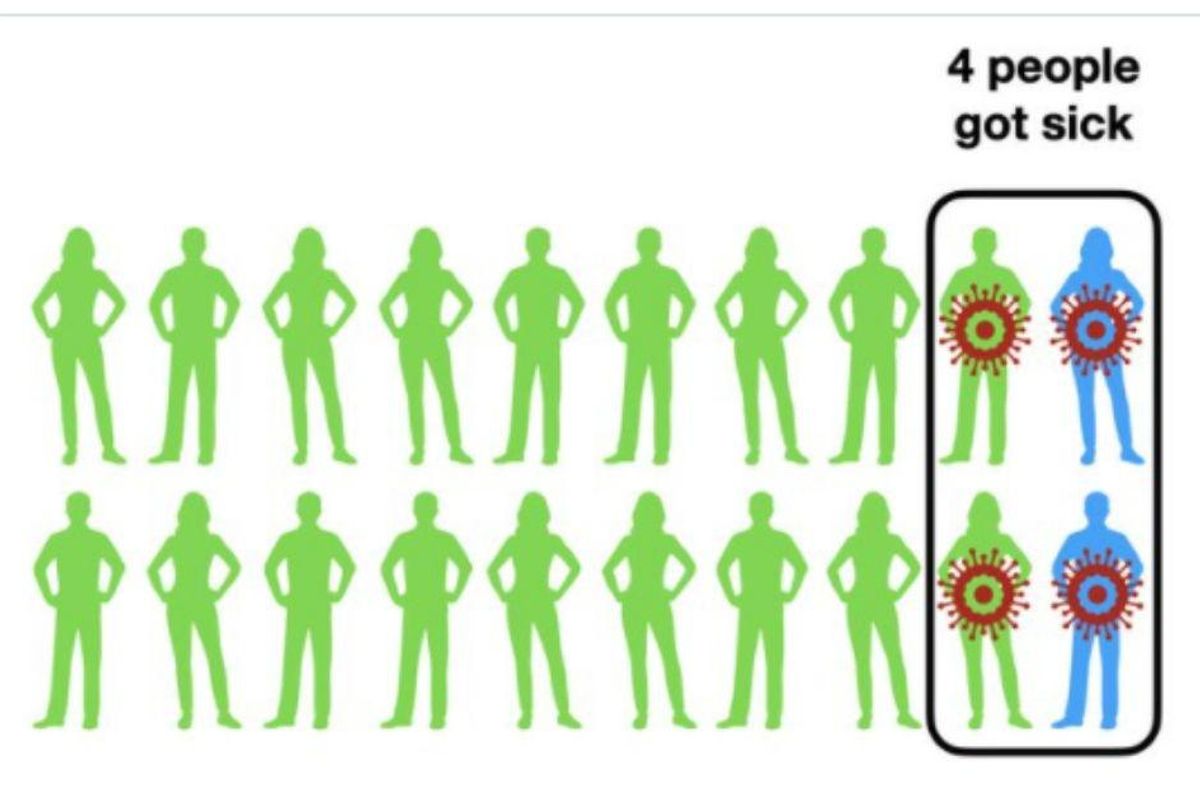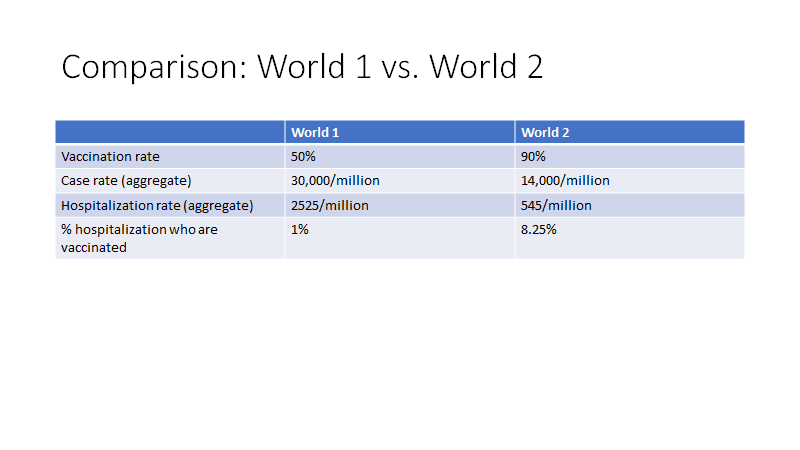The reassuring math explaining COVID hospitalization percentages for vaccinated people

As if dealing with an ever-changing understanding of the novel coronavirus over the past year and a half hasn't been enough, we've also had to try to understand the math behind the data analysis, which for some of us (hi, English major here) is a nightmare.
It's vitally important that we understand these numbers, though, because misinformation peddlers are using them to push misconceptions about vaccines. And even though the math isn't actually that complicated, those of us who aren't particularly mathematically inclined may read headlines like "50% of COVID patients in XX hospital are fully vaccinated" and find ourselves alarmed. Wasn't the vaccine supposed to prevent hospitalizations? If half of the people in the hospital are vaccinated, doesn't that mean the vaccine makes no difference?
Well, no. That's not at all what it means, and here's why. It's all about the denominators.
On a super basic level: 2 = 2, but 2 out of 20 is not the same as 2 out of 80. If 4 people are hospitalized, 2 vaccinated and 2 not vaccinated, in an area with an 80% vaccination rate, it's not a meaningful measurement to say that half of the hospitalizations are in vaccinated people. Your chances of hospitalization with the vaccination are significantly lower because of the denominator.
Biostatistician Lucy D'Agostino McGowan simplified why the percent vaccinated in hospitalizations numbers aren't as scary as they sound with some helpful visuals in a Twitter thread.
If you see something like x% of the sick/hospitalized/deceased were vaccinated, the *better* the vaccine uptake the *scarier* this number will seem! It is using the wrong denominator. For example, here is a scenario with 90% vaccination, 4 people got sick: 2 vaxed 2 unvaxed\n\n2/6pic.twitter.com/ThwLJY2Cl8— Lucy D\u2019Agostino McGowan (@Lucy D\u2019Agostino McGowan) 1626739726
What you need to do is look at the rates among the vaccinated and unvaccinated separately, and then compare them. Here 11% of the vaccinated got sick, 100% of the unvaccinated got sick.\n\n4/6pic.twitter.com/wNRyoDXM6C— Lucy D\u2019Agostino McGowan (@Lucy D\u2019Agostino McGowan) 1626739729
The director of the Maine CDC, Nirav D. Shah, gave an even more thorough explanation for those who actually want to wade a little deeper into the statistical waters.
2/I have seen folks express concern upon learning, for example, that 45% of people hospitalized w/COVID19 are vaccinated. \n\n"But I thought the vaccine keeps you out of the hospital? Is this evidence that vaccines aren't working?" No, it is not. \n\nI'll walk through why here.— Nirav D. Shah (@Nirav D. Shah) 1627936881
He wrote:
"It's important to consider the full picture when interpreting data on things like the % of people fully vaccinated who are hospitalized with #COVID19, or the fact that 74% of the cases in the P-town outbreak were fully vaccinated.
I have seen folks express concern upon learning, for example, that 45% of people hospitalized w/COVID19 are vaccinated.
"But I thought the vaccine keeps you out of the hospital? Is this evidence that vaccines aren't working?" No, it is not. I'll walk through why here.
First, some basic assumptions. There are two Worlds, each with 1M people. And we'll consider the same infectious disease affecting each World, with the parameters below.
There is also a vaccine, with the effectiveness parameters noted below. These could all be changed. In World 1, 50% of the population has been vaccinated against the disease. Out of the 1M people, there are 30,000 infections and 2525 hospitalizations.
In World 1, 50% of the population has been vaccinated against the disease. Out of the 1M people, there are 30,000 infections and 2525 hospitalizations.
Among vaccinated folks, 25 end up in the hospital. The other 2500 hospitalized are UNvaccinated. World 2 is different: 90% of the population is vaccinated.
World 2 is different: 90% of the population is vaccinated.
Here, there are only 14,000 cases. And only 545 people are hospitalized in total.
BUT, 45 of the hospitalized are vaccinated! Compare that with only 25 vaccinated folks in the hospital in World 1. What is going on?
What is going on?
How could it be that, in a World with 90% of the population vaccinated, 20 *more* vaccinated people are hospitalized with the disease (45 vs. 25?)? Is the vaccine not working in World 2?
It's important to compare World 1 and World 2 side by side.
First, note that the case rate in World 2 (90% vaccinated) is far lower than in World 1 (50%). The vaccine is working.
Second, the hospitalization RATE is also far lower in World 2: 545/million vs. 2525/mil. But because there are simply more vaccinated people in World 2, something that affects them at the same rate as others (hospitalization) will generate more cases, numerically.
But because there are simply more vaccinated people in World 2, something that affects them at the same rate as others (hospitalization) will generate more cases, numerically.
Indeed, the % of all hospitalized who are fully vaccinated is HIGHER in World 2 than in World 1. In World 2 (90%), 8.25% of all those in the hospital are vaccinated. But in World 1 (50%), it's only 1%!
In World 2 (90%), 8.25% of all those in the hospital are vaccinated. But in World 1 (50%), it's only 1%!
This is NOT evidence that the vaccines are ineffective. It is a function of the fact that there are simply more vaccinated folks in World 2 relative to unvaccinated.
The question to ask yourself is this: which world would you rather be in?
For that, you would look to the hospitalization rate: 545 vs. 2525/million. World 2, with its higher vaccination rate, is preferable, given that it experiences 1980 fewer hospitalizations. In World 1, fewer people are vaccinated, so their rate of hospitalization is just lower.
Where else does this (common) phenomenon occur?
For a stark example, consider this: what % of skydiving accidents occur in people who were wearing a parachute? Probably 100%.
Are parachutes not effective? They are. But the baseline rate of parachute wearing among those who sky dive is 100%.
Another example: what percentage of fatal car accidents occur in people who were wearing a seat belt? It's about 52%.
Does that mean the effectiveness of seat belts is a coin flip? No, the baseline rate matters. Seat belt usage is around 85%. As with so many things, where you end up depends on the baseline rate of where you started.
Lots of vaccinated folks are being hospitalized with COVID because there are a growing number of vaccinated folks. But the RATE of total hospitalizations is going down. That's good. Similarly, in P-town, 74% (346) of the cases were among vaccinated folks.
But there, what percentage of folks were vaccinated vs. unvaccinated? If the baseline rate of vaccinated was sky high, then this finding is entirely predictable. This is a common theme in epidemiology and statistics. Once you know to look for it, it jumps out all over the place. But without the context around background rates, denominators, etc., it's easy to scare yourself and make incorrect decisions.
Another example: imagine World 3, also with 1M people. 999,999 are vaccinated.
Two cases of COVID occur. One in the unvaccinated person. The other in a vaccinated person.
So 50% of new COVID cases are in the vaccinated. Really? Yes, but deceiving. Denominators matter."
Denominators matter. Even those of us who aren't mathematicians or statisticians can understand that, but we do need media reports to be clear about it; otherwise, we end up with people believing that the vaccines don't do much.
We also need to remember that data is always being gathered and that our understanding of this virus, the vaccines, and how best to balance safety measures and other needs will continue to evolve. The constant shifts are hard, but such is the nature of a novel viral pandemic, and it looks like we're still going to be in it for a while.
- An ER nurse describes patients denying they have COVID—even ... ›
- Most COVID vaccine disinformation can be traced to just 12 people ... ›
- COVID vaccine misinformation is out of hand. Let's examine some of ... ›
- Funeral home truck has simple message: 'Don't get vaccinated' - Upworthy ›
- Funeral home truck has simple message: 'Don't get vaccinated' - Upworthy ›
- Math teacher shows how to add and subtract from left to right - Upworthy ›
- Ever wonder why people 100 years ago died so much younger? It's these 14 reasons. - Upworthy ›





 Rihanna Nails GIF
Rihanna Nails GIF A photo of Helen and Bill in their uniformsImages provided by Drew Coyle
A photo of Helen and Bill in their uniformsImages provided by Drew Coyle The map provided by Helen to Bill@crewdoyle/
The map provided by Helen to Bill@crewdoyle/ Helen and Bill, happy and and content, and oh so in love. Image from Drew Coyle
Helen and Bill, happy and and content, and oh so in love. Image from Drew Coyle Good luck trying to catch a gazelle.
Good luck trying to catch a gazelle. Chickens will eat just about anything.
Chickens will eat just about anything. There's actually a big difference between horses and zebras besides just the stripes.
There's actually a big difference between horses and zebras besides just the stripes. A photo of a portable carbon monoxide detector from Amazon
A photo of a portable carbon monoxide detector from Amazon


